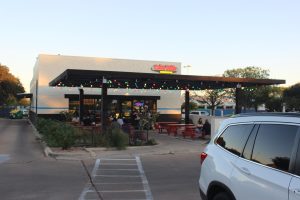New roads cause problems
January 29, 2018
Recent construction on highway TX-45, or 45SW, has captured the attention of teachers and students living in the area, having the potential to disrupt their commutes in the morning and afternoon. Eligible voters decided on the construction back in 2015, but this action neglected to consider the effects it would have on student drivers in the morning.
The new road will be a four lane toll road between highways MoPac & 1626. Ideally, this new highway will reduce congestion on roads like Brodie, Manchaca, and Slaughter. According to the city of Austin, drivers using 45SW should expect to save 9-17 minutes when driving to Central Austin. However, many students that live in neighborhoods like Meridian, Avana, and Grey Rock Ridge use 45 to get to school in the morning. According to construction studies done by the city, traffic will increase on the south end of MoPac between William Cannon and 45 once 45SW is built. As of now, it takes around 10 minutes to get from these neighborhoods to Bowie in the morning. With 45SW in place, it is likely that drivers will opt to use the new route to reach MoPac instead of Brodie and Manchaca. However, the city has plans to build underpasses at both Slaughter and La Crosse that will ideally reduce build-up at those intersections.
Unfortunately, the construction of this underpass is still being protested, meaning it will not be finished until after 45SW. With the predicted congestion on top of construction of these underpasses, residents will likely see even worse commute times in the morning and evening. To avoid this, the city should have decided to build the underpass first in order to help relieve traffic before it became a problem.
Conversely, the Green Mobility Challenge, launched in 2011, challenges architects, planners, and engineers to provide more environmentally safe ways of constructing and maintaining construction projects. As a result of this initiative, 45SW will be constructed incorporating more environmentally-conscious methods, such as aligning the road to avoid harming the Edwards Aquifer recharge zone, working around the terrain to preserve it (i.e. building a bridge over Bear Creek), using all electronic rolling, including a sidewalk/bike path, using recycled materials where possible, and taking water quality protection measures to avoid/minimize runoff from the road. Despite the problems this road is going to create, it is nice to finally see some environmentally-conscious decisions being made within the government. With the dangerous state of our planet, large corporations and state governments need to be taking more action to preserve the natural world.
Additionally, to help prevent animals from crossing the roadway, wildlife fencing has been proposed to be constructed along the project.
This wildlife fencing has great potential to lessen the amount of future accidents caused by deer, which has proved a frequent issue in the 45-area, and is increasing in the state of Texas as a whole. According to a study done by insurance company State Farm, one in every 288 Texas drivers will make claims for deer-related damage to their cars, which is a 3% higher risk than last year’s. The institution of this fencing will hopefully stop deer from darting into the road and colliding with drivers in what could possibly be fatal crashes.
45SW is set to open in 2019, and could potentially connect to I-35 in the future. Access to 45SW will be available from FM 1626, Bliss Spillar Rd, MoPac, or 45. Given that the construction of this road is already underway, it cannot be halted. Although the city of Austin has done their best to make 45SW an environmentally conscious and wildlife safe road, the traffic created by construction and the eventual frequent use of the road will make commutes to and from school for students living in the area especially lengthy.
In the future, we should be allowed to speak up about projects that will affect us–the city of Austin is about more than just the voices of our parents.









